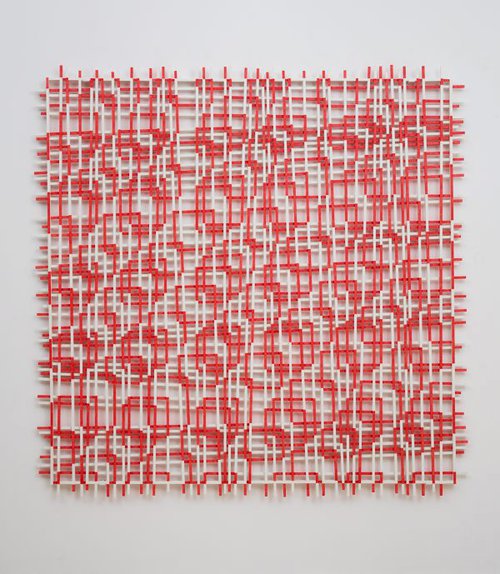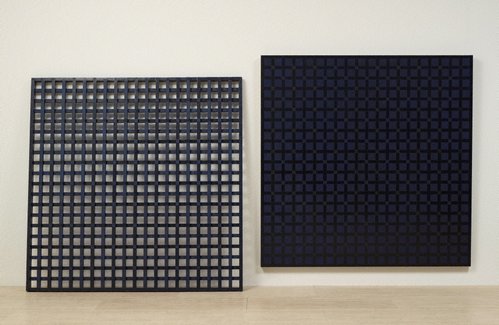-
Details
- Date
- 1987
- Media categories
- Sculpture , Painting
- Materials used
- two timber grids, oil paint
- Dimensions
-
229.5 x 234.0 x 6.0 cm overall
:
a - left panel, 229.5 x 117 x 6 cm
b - right panel, 229.5 x 117 x 6 cm
- Signature & date
Not signed. Not dated.
- Credit
- Rudy Komon Memorial Fund 1988
- Location
- Not on display
- Accession number
- 506.1988.a-b
- Copyright
- © Hilarie Mais
- Artist information
-
Hilarie Mais
Works in the collection
- Share
-
-
About
When critic Rosalind Krauss noted that ‘the grid is an emblem of modernity … it is what art looks like when it turns its back on nature’, she described the essence of Hilarie Mais’ ‘Grid: doors II’.1 Mais has devoted much of her career to exploring the grid’s potential as content and composition, a fascination derived from a confluence of interests, both professional and personal. Mais uses the grid as a contemporary and technological artefact, the symbol of the human intellect, but if this is logic, it is logic defied: her use of the grid straddles both reason and emotion.
‘Grid: doors II’ offers precision and clarity, but a profound and disorienting optical experience as well. It rests on the wall like a painting yet sits proud on the floor like sculpture. Paradoxically, the grid structure bridges wall and floor as a prop while needing support. As something between image and object, ‘Grid: doors II’ intrudes into the viewer’s space yet still exists within the sphere of illusion. The grid is solid, yet transparent – enough to allow a tantalising access while simultaneously denying passage. In this work, as the title suggests, the square grid is divided like a pair of doors, reiterating the possibility of discovery and frustration. Mais often pairs complementary parts, as in ‘bearing effigy’ 1994 (AGNSW collection), to effect a powerful symbolism of partnership, of mirror and reflection and of indivisible relationships.
Interviewed in 2002, Mais stated that ‘my work about the grid, referring to doors, windows, screens, implying passage, crossing, journey, the threshold to the other side, both physically and meta-physically, elements occurring in much religious art and architecture. Also the issue of the temporal zone, the other side, inner-life, the life of the spirit, the female place, the inner sanctum. The veil or barrier to inner knowledge ('sanctum sanctorum'), these are all moments of revelation; these I see as spiritual states’.2
Mais does not have her sculptures fabricated but rather constructs them herself, fitting the parts together visually so that they have a handmade look rather than a machine aesthetic. Each grid square is ‘Vitruvian’, in that it is based on the dimensions of her body and outstretched arms, and, mirroring her proportions, is thus a reflection of self. Mais complements the craft approach in her construction with a painterly attitude to colour, staining the wood with pigment, layer by layer, until the right blue/black hue has been achieved. Secondary layers in ‘Grid: doors II’ cause it to cast a shadow in the form of an ‘x’, as if the ghost of the artist still lurks in the grid. Rack, prison, portcullis, door, map: the grid as matrix for the projection of shadow brings together the real and the imagined.
1. Rosalind Krauss, ‘Grids’ in 'The originality of the avant-garde and other modernist myths', The MIT Press, Cambridge Mass 1988, pp 9, 10
2. Hilarie Mais interviewed by Melanie Eastburn in ‘Hilarie Mais: time and sculpture’, 'World Sculpture News', vol 8, no 4, autumn 2002, p 37© Art Gallery of New South Wales Contemporary Collection Handbook, 2006
-
Exhibition history
Shown in 5 exhibitions
Hilarie Mais, Roslyn Oxley9 Gallery, Paddington, 27 Sep 1988–15 Oct 1988
Hilarie Mais, Plimsoll Gallery, University of Tasmania, Hobart, 24 Aug 1990–30 Sep 1990
Hilarie Mais, Contemporary Art Centre of South Australia, South Australia, 02 Nov 1990–30 Nov 1990
Great gifts, great patrons, Art Gallery of New South Wales, Sydney, 17 Aug 1994–19 Oct 1994
Fathoming: Contemporary Australian Sculpture, Manly Art Gallery and Museum, Manly, 01 Aug 2003–07 Sep 2003
Hilarie Mais: retrospective 1982-2004, Drill Hall Gallery, Australian National University, Canberra, 20 May 2004–04 Jul 2004
-
Bibliography
Referenced in 10 publications
-
Art Gallery of New South Wales, Great gifts, great patrons: an exhibition celebrating private patronage of the Gallery, Sydney, 1994. no catalogue numbers
-
Anthony Bond and Victoria Lynn, AGNSW Collections, 'Contemporary Practice - Here, There, Everywhere ...', pg. 229-285, Sydney, 1994, 242 (colour illus.).
-
Michael Desmond, Contemporary: Art Gallery of New South Wales Contemporary Collection, 'Abstraction', pg.16-59, Sydney, 2006, 19, 46 (colour illus.).
-
Bruce James, Art Gallery of New South Wales handbook, 'Australian Collection: Painting and Sculpture', pg. 102-181, Sydney, 1999, 177 (colour illus.).
-
Anne Loxley, Hilarie Mais, 'Essay', pg. 7-22, Sydney, 1995, 20, 43 (colour illus.).
-
Victoria Lynn, Art and Australia (Vol. 31, No. 2), 'Minimalism and its shadows: girding the grid', pg. 234-243, Sydney, Summer 1994, 238, 240, 242 (colour illus.).
-
Terence Maloon, Contemporary Australian painting, 'Commitment to abstraction: one existent to the other', pg. 51-82, Sydney, 1990, 57 (illus.).
-
Robert Raymond, 52 views of Rudy Komon, Sydney, 1999, 164.
-
Nick Waterlow (Director), The 1988 Australian Biennale: from the Southern Cross: a view of world art c.1940-88, Sydney, 1988, 185 (colour illus.). no catalogue numbers
-
Donald Williams and Colin Simpson, Art now: contemporary art post - 1970, Sydney, 1994, 105 (colour illus.). fig. 5.17, as Private Collection
-




